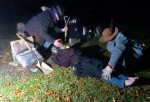Digging up the dead

Imagine yourself as a medical student back in the 1830s. In order to get a better understanding of the human anatomy, you and your friend have just snatched the body of a recently buried person because cadavers are hard to come by. Unfortunately for you and the school, your theft did not go unnoticed, and now 300 angry citizens of Hubbardton with axes and torches in hand, are banging on the chapel doors demanding the return of the body.
Although it seems hard to imagine, that was the scene back when the Castleton State College Old Chapel was known as Castleton Medical School.
According to several documents and articles describing the “Hubbardton Raid,” in November of 1830, two Castleton medical students were caught robbing a grave in the name of science. The body they dug up was that of a woman named Penfield Churchill. The dean of the school at that time stalled the 300 men from Hubbardton while inside the two students were cutting off Churchill’s head to prevent her identification. One student hid the head under his coat and escaped out the back, while the other stuffed the body under the floorboards.
Upon entrance to the medical school, the townsmen could see no trace of the body, according to published reports of the incident. However, while walking around, one of the men stubbed his toe on a loose floor board, which led to closer inspection and the finding of the headless body of Churchill.
To appease the public, Castleton expelled the two students as long as charges were dropped and the head returned, according to the Journal of the American Medical Association.
Karen Sanborn, who directs Castleton State College’s media services and handles archival duties, found many articles explaining the events that took place. Although her knowledge of the “Hubbardton Raid” consists only of what the documents and articles explain, she spoke about how students have reacted after hearing of the raid.
“I’ve had work study students refuse to work there,” said Sanborn. “Students have heard strange noises from the building. I myself don’t think about it. I’ve heard the building creak, but old buildings creak.”
The antiquated building on Seminary Street holds a lot of history lot for both the college and the town. And while it is now used primarily for meetings and events, surgical tools in glass cases on the first floor give glimpse of its former uses.
Academic Dean Joe Mark called the chapel an important symbol for Castleton.
“The old chapel is an attractive space for meetings, inductions, and classes. It was used as a dormitory throughout the 1920s and ’40s and housed music classes in the 1960s. In 1969, the state of Vermont wanted to tear the chapel down and build a Fine Arts Center in its place. The Alumni Association opposed and managed to move the building to its present location and the Fine Arts Center was built,” Mark said.
At the mere mention of the “Hubbardton Raid,” Mark’s eyes instantly lit up with excitement. He talked about the difficulty in finding cadavers during the 1800s and how different ideas were then about the donation of a body for science.
“I have mixed feelings about the events that took place back then. On one side I’m sympathetic because it was so hard to find cadavers, which is critical to the teaching of medical practice. On the other side, it was also a serious violation to the norms of that day. I’m just glad I wasn’t dean then,” he said.
Students around campus, for the most part, were totally unaware of the infamous body snatching and subsequent raid, and looked dumfounded when told about it.
“I had no clue that something like that went down. Sort of makes you wonder what other kinds of stories Castleton has,” said student Ryan Beddie.
“Doesn’t surprise me one bit,” added his friend, Andrew Rissman. “I always get these weird vibes when I step into that place.”
Some students didn’t believe it, saying the raid was probably just made up. But others, like freshman Eric Derouchie, almost seemed freighted after hearing the story.
“Wow! That’s the craziest thing I’ve ever heard. That chapel looks so peaceful; it’s hard to imagine an angry mob ready to storm in. I’m pretty sure I’ll never go in there unless I have to,” Derouchie said.




